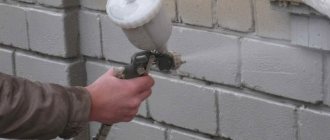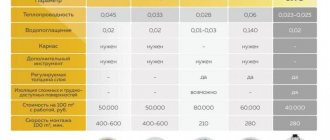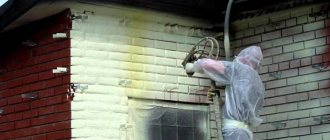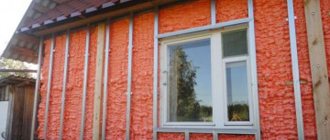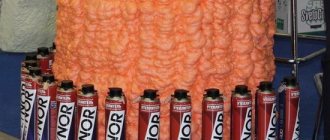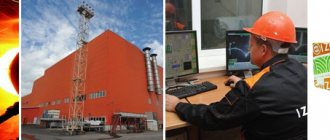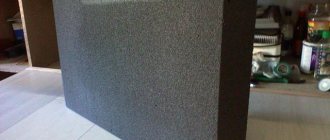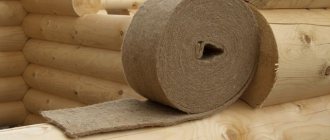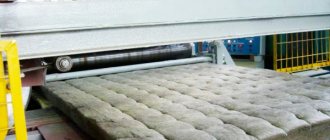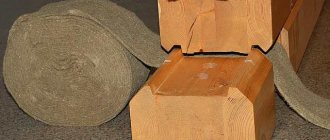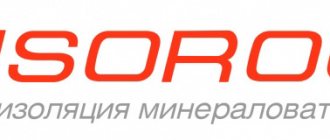Possibility of using foam fillers
Balloon thermal insulation , although better than its analogues in all respects, was not widely used in the past due to its high cost. And the use of such insulation was limited by the need to use special equipment, which, due to its price and complexity of development, is practically inaccessible outside the professional sphere. Much simpler and more profitable, although not always more convenient, was the use of mineral wool and polystyrene boards, which are made by extrusion.
Then manufacturers began to produce sprayed insulation in compact-sized cylinders, which led to a reduction in the cost of the method. To spray such a mixture of steel, complex installations and specialists in thermal insulation finishing are not needed, since the material itself is filled into small containers and the possibility of manual spraying is provided. Each cylinder is designed to cover one square meter of base (layer up to 60 mm thick). One person can process up to one hundred square meters per day.
As a result, calculations showed that working with insulation such as Polyno r is much more profitable in terms of labor costs , costs for the materials themselves and surface preparation. If a professional team of workers charges up to one and a half thousand rubles for insulating one square of wall, then using Polinor insulation with the same amount of material, you need to spend only about 500 rubles. You can work independently, which eliminates the need to look for experienced workers, reduces finishing time, and saves money.
The choice of thermal insulation of this type remains the only optimal option that is available to people without special training. Foam can be used to create insulation for foundations, basements, walls inside and outside buildings made of brick, stone, concrete, and blocks. This option is also suitable for thermal insulation of non-load-bearing coatings, including floors on joists, as well as pitched roofs and attic floors.
Since Polinor is suitable for application to bases made of almost any material, it can be used as thermal insulation for plumbing fixtures and sewer pipes or fittings. In such cases, foam insulation in cylinders can be used indoors or in open areas. There is only one limitation on the use of balloon thermal insulation, which is that the material cannot be used to foam voids. It can only be applied to a dense base.
Scope of application
I’ll probably call this insulation “folk”. Why? Because working with it does not require special knowledge, and therefore, no search for third-party performers. If we are talking about small “private” volumes of insulation, then you can handle it yourself.
Polinor is used for insulation:
- External and internal walls of residential and non-residential premises built from almost any building material;
- Floors with a so-called non-load-bearing structure and cavities between the joists;
Gun with nozzle - pitched roof;
- Basement, basement, foundation;
- Garage and other non-insulated doors (from the inside);
- Heating pipes, water supply, sewerage and other communications;
- Containers, baths, cisterns;
- Loggias, balconies, attics, verandas and attics;
- Transport kungs, wagons, insulated vans, painting booths, etc.
Just in case, let me clarify - it (Polinor) has an orange-pink color.
Advantages of using thermal insulation with spraying
Compared to sheet analogues, Polynor sprayed insulation saves time and money, and is easy to store, transport and use. This material also has a number of other advantages:
- minimum curing time (up to one hour);
- resistance to destruction by insects and rodents;
- complete surface coverage without the formation of cold bridges;
- no harmful effects on humans and the environment;
- spraying without complex and expensive devices;
- base vapor barrier;
- long service life.
The insulation is non-flammable and quickly extinguishes when overheated, which guarantees a high level of fire safety.
Features and scope
The technology for applying sprayed polyurethane foam may vary depending on the type of surface that is insulated with this insulator.
Concrete . Before starting to create an insulating layer of sprayed polyurethane foam, high-quality preparation of the concrete surface is carried out. It is cleaned with an abrasive. Then polymer-based primers are applied. The use of these materials ensures dust removal from the polyurethane surface.
Iron . When the material is applied to a metal surface, its preparation is also carried out. It involves grinding the seams present on the metal, removing scale, degreasing and processing with abrasive materials.
Tree . Preparing a wooden surface involves thoroughly drying it before applying polyurethane foam to it. You should know that wood is a material that has the ability to “breathe”, so for thermal insulation work it is best to use polyurethane foam with an open-porous cell structure. It is also possible to use a closed-porous type insulator, but only if the density of the material is low. To ensure protection of the created insulating layer from unfavorable factors - moisture and ultraviolet rays, a special membrane is laid on the surface of the thermal insulation coating.
Where is polyurethane foam used?
Objects for a wide variety of purposes can be protected by spraying polyurethane foam. This method of surface insulation is most widely used in the following areas:
- Construction;
- housing and communal services;
- Petrochemical industry.
Owners of private houses and people living in apartments are naturally interested in the issue of household use of polyurethane foam for insulating surfaces . In this regard, it can be noted that the use of sprayed polyurethane foam allows us to provide not only high-quality insulation of building structures, but also good sound insulation. It can be used not only in apartments and country houses, but also in baths and saunas. This material is also used for roof insulation. It is also used to insulate openings of windows and doors.
Main technical indicators
Foam thermal insulation in all respects is much better than conventional insulation materials , since its technical characteristics are comparable to industrial samples sprayed by pneumatic units. These basic parameters of Polynor include the following items:
- thermal conductivity in the range of 0.023−0.025 W/μ;
- density of the material after hardening - more than 28 kg/m³;
- vapor barrier at 70%, which is similar to “Izospan V”;
- moisture absorption - up to 2% (immersion in water at a temperature of about +100 ºС for 1.5 hours);
- maximum operating temperature - up to +121 ºC with an exposure time of up to one year;
- material life without reduction in technical characteristics - at least 50 years;
- environmentally friendly and suitable for use in residential premises.
Sprayed thermal insulation in cylinders withstands mechanical deformations (up to 50%) while maintaining volume and without destruction or loss of a given shape.
Insulation can be applied to surfaces made of metals (aluminium/cast iron/steel), brick, concrete structures, wood materials (plywood, boards) with adhesion at a level of 1−2.5 kg/cm². At the same time, sprayed thermal insulation in cylinders is resistant to humidity and chemicals in the form of organic solvents, oils, and soap solutions. The ingress of methyl chloride, dichloroethane, and hydrochloric acid leads to swelling, and sulfuric or nitric acid completely destroys the structure of the insulation.
Application Features
Teplis heat insulator is very convenient to use. Its application is carried out as follows:
- Dirt, dust and oil stains are removed from the working surface.
- The container with insulation is heated to +18-20 °C and shaken thoroughly.
- A mounting gun is screwed to the tip of the cylinder.
- A special nozzle is put on the gun and placed in a horizontal or vertical position (based on the method of applying the mixture).
- By pressing the trigger of the gun, the surface is covered with the first layer of heat-insulating material. After 20 minutes, the product is sprayed again.
Important!
During operation, the container must be shaken periodically. Teplis insulation is economical, because its use does not require the installation of a frame. In addition, installation is carried out without additional materials (glue, membrane, films).
Advantages of sprayed thermal insulation
Are you looking for the best way to insulate your home? Spray insulation is just what you need. This option has a lot of undeniable advantages. Among them:
- environmental friendliness;
- water absorption;
- anti-corrosion protection;
- excellent adhesive properties;
- low thermal conductivity;
- excellent sound insulation;
- durability;
- resistance to mechanical damage;
- integrity of the thermal insulation layer;
- biological neutrality, uninteresting for fungi, mold, rodents;
- fire safety;
- ease of use;
- resistance to climatic factors;
- high but reasonable cost;
- practicality and possibility of use when working with structures of complex shapes and hard-to-reach elements;
- resistance to aggressive chemicals;
- cost-effectiveness (there is no need to use a vapor barrier, wind- and moisture-proof film);
- ease of maintenance (during operation, the insulation does not require updating).
Based on the above properties, we can say that sprayed thermal insulation allows:
- reduce heating costs and neutralize heat losses;
- prevent cracks from appearing in the building;
- provide high-quality sound, steam and heat insulation;
- increase the service life of the house;
- remove steam condensation;
- eliminate heat leaks through seams;
- do not harm the environment.
Comparisons of POLYNOR with other insulation materials
POLYNOR (polynor) - can be compared with many materials and insulation materials, but we will focus on the most basic ones.
We consider the economics or the true cost of insulation When choosing any product or building material, the question always arises regarding the price/quality ratio. I would like to do everything efficiently, relatively inexpensively and not return to this issue for a long time. When insulating, it is not enough to choose the insulation you like based only on the cost and its physical and chemical properties, but you also need to understand what additional costs will arise during the work. Let's consider this using the example of traditional insulation materials: polynor, mineral wool, expanded polystyrene and polystyrene foam for an insulation area of 100 m2. The thermal conductivity coefficient of Polynor thermal insulation is 0.023 W/(m*deg.). This is the minimum indicator among the insulation listed above! The number of closed cells is 70%. Based on this and similar parameters for other insulation materials, the thicknesses required for insulation, all other things being equal, were determined: Polynor-5cm.
Mineral wool -15cm.
Expanded polystyrene-13cm.
PSB-S15U -15cm.
Accordingly, the required volume and cost of the material itself (at Leroy Merlin prices as of December 5, 2014):
Polynor - 5m3 (or 100 cylinders) X 325 rub. = 32500 rub.
Mineral wool (Ursa Terra 34PN, 50mm.) - 15m3./70rub. per m2. 21000 rub. Expanded polystyrene (URSA XPS, 50mm.) - 13m3. /224 rub. per m2. 58240 rub. Polystyrene foam (PSB-S15U, 1x0.6x0.03) - 15m3/36.3rub. per m2. 18150 rub.
Now let's move on to the second part of the question - additional costs for installing thermal insulation, the cost of work and delivery of insulation materials to the construction site.
Transportation. Polynor is produced in cylinders with a capacity of 1 liter, the covered area is 5 cm thick. is 1m2. For 100 m2 you will need 100 cylinders or 9 boxes. Transportation costs are insignificant, unlike other compared insulation materials. Their transportation requires special transport.
Cost of work. Polynor is a high-tech material, there are no requirements for the preparation of the insulated surface, it does not require lathing or vapor barrier, any person without special skills can apply PPU insulation. As a rule, construction company prices for work are 90-100% of the cost of the material itself, but this does not apply to the Polynor brand. You can apply it yourself or negotiate at your own discretion (maximum 30% of the cost of the material).
At Leroy Merlin prices as of 12/05/2014:
Vapor barrier Izospan, roll 70m2-950rub/piece.
Hydro-windproof membrane Izospan AM, roll 35m2-30 RUR/m2.
Mounting adhesive Tytan Prof Classic Fix - 139 RUR/pc.
Cost of thermal insulation materials per 100m2
| thermal insulation | sheathing | counter-lattice | vapor barrier | hydro windproof membrane | assembly adhesive | sum | |
| polynor | 32500 | 1120 | No | No | No | No | 33620 |
| mineral wool | 21000 | 8925 | 4200 | 1360 | 3000 | No | 38485 |
| expanded polystyrene | 58240 | 8925 | 4200 | 1360 | 3000 | 2363 | 78088 |
| Styrofoam | 18150 | 8925 | 4200 | 1360 | 3000 | 2363 | 37988 |
The cost of the required materials was calculated based on the amount of materials used:
- Edged board: distance between logs 1 m. Board section: 0.02X0.08m. Cubic capacity: 100X0.02X0.08=0.16m3. Cost: 0.16m3X7000rub.=1120rub. 1a. This section of the board when insulating Polynor is necessary and sufficient to ensure the solidity of the entire insulated structure as a whole, eliminates the temperature gradient, cold bridges and moves the dew point outside the insulated plane.
- Lathing + counter-lattice: Cell format - 0.6X1.2. With this format, the amount of timber per 100m2 is 25 pieces with a length of 10m. Section of timber: 0.05X0.15m. Cubic capacity: 250X0.05X0.15=1.875m3. Cost: 1.875m3X7000rub.=13125rub.
- Vapor barrier: Cost: 100m2-1360rub.
- Hydro-windproof membrane: Cost: 105m2-3150rub.
- Assembly adhesive: 17 pcs x 139 rubles = 2363 rubles.
Durability of materials:
Mineral wool: 5-7 years (further absorbs moisture and becomes deformed)
Expanded polystyrene: PPS_JSC JV Tigi Knauf _ GOST 15588-70_13 years EPPS_NPP "Expol"_TU 2244-001-17953000-97_34 years EPPS_ZAO "Khimich. Plant"_TU 2244-002-17953000-95_16 years Eps Flomate_ "Dow Chemical"_DIN 4108_37 years Eps Roofmate_ "Dow Chemical"_DIN 4108_40 years Foam plastic: at least 30 years Polynor : 45 years
Thus, to summarize: we see that Polynor is in the middle price segment between mineral wool and expanded polystyrene, but in terms of the totality of all costs for arranging thermal insulation, durability and transportation, it is confidently in the lead.
Cost of work and materials
The cost of insulating walls with sprayed polyurethane foam consists of the cost of purchasing the material, which is offered on the market in cans, and carrying out the work.
When determining the volume of work performed, they proceed from cubic meters of insulated surface or calculate the volume in square meters, depending on the thickness of the layer and the type of polyurethane foam used. Depending on the calculation method, the price for such insulation can be from 12 thousand rubles. per cubic meter or from 750 rubles. per square meter. If the owner of a building decides to insulate structures with sprayed polyurethane foam with his own hands, he, of course, will need to purchase the material itself in sufficient quantities, and in addition a set of equipment. Before starting work, you will have to understand the specifics of using the equipment and learn all the intricacies of PU foam insulation technology.
